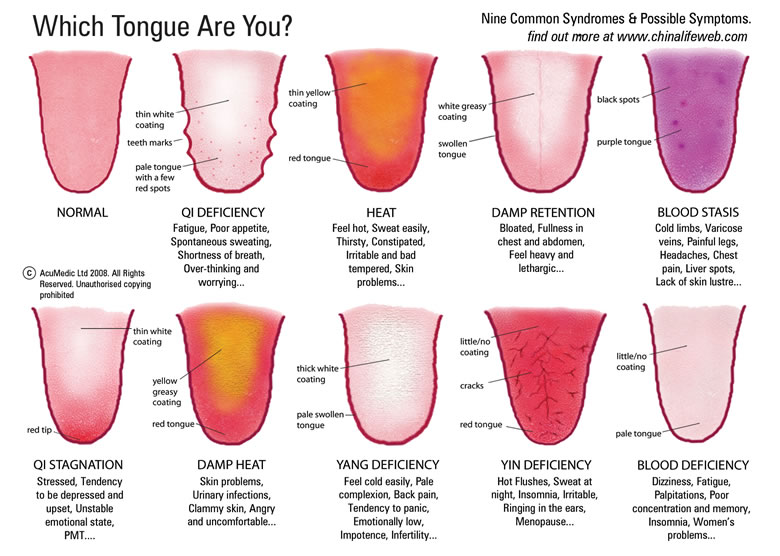By Jennifer Dubowsky, LAc
Chinese tongue diagnosis is an essential tool used by acupuncturists and traditional Chinese medicine practitioners. Your tongue plays a unique role in understanding your body’s constitution; it is the only organ that is both interior and exterior.
When I examine your tongue, I systematically look at very specific characteristics and I learn a lot about the interior of your body and the state of your health. Tongues differ from one person to the next and, although people probably take them for granted, they have a lot to tell me if I look carefully. Your tongue provides a window into how your body is functioning, for example, each tongue will change as its owner ages or experiences improvements or declines in health.
The basics of Chinese tongue diagnosis
When Chinese medicine practitioners look at your tongue, we observe: shape and size, color, and coating. I’ll explain:
Shape and Size
The shape and size of the tongue tells the tale of the fluids running through the body. For example, a small, short tongue may indicate an insufficient amount of moisture in the body. In comparison, a very large, puffy tongue with indents on the edges of the tongue could indicate that fluids are not flowing through the body as easily as they should.
Color
Ideally, the healthy tongue body looks pink and vital. Of course, the natural tongue color can vary from person to person, but taken in conjunction with other information, it is still a very good indicator of what is happening inside your body. For example, a red tongue points to heat in the body. The redder the tongue, the greater is the amount of heat. On the other hand, a pale tongue could mean that there is not enough heat in the body, or that there is a deficiency of qi or blood. For an example on the tongue chart above, see the last tongue on the bottom row entitled “blood deficiency”.
Coating
Does your tongue have a thick or thin coating? The coating, called fur, depends on many factors and changes more quickly than the tongue body. Normally your coating is thin. If you are getting sick, you may see a thicker coating developing. The consistency of the tongue’s coating also indicates the state of the fluids in the body. A dry coating represents a drier body just as an excessively moist coating indicates a damp body or poor fluid circulation. The lack of a coating indicates a more severe heat or dryness in the body. This is sometimes seen in women going through menopause, a time when women’s bodies start to heat up. For an example, look at the tongue that is second to last in the bottom row entitled “yin deficiency”. Tongue coatings also come in different colors. A thin white coating is normal. A yellow coat is a heat sign especially when combined with a red body (example the middle tongue “heat” in the top row). Gray or black coating colors also exist, and indicate a severe condition; luckily I don’t see those colors often.
Look at your own tongue
When I am asked to speak to interested groups, I often bring a hand mirror to pass around so people can take a look at their own tongue. I also have participants check out their neighbor’s tongue as a comparison. People are surprised by the differences they see from tongue to tongue because they pay little attention to their tongue shape, color and coating. Next time you look in a mirror, give it a try!
Jennifer Dubowsky, LAc, is a licensed acupuncturist with a practice in downtown Chicago, Illinois, since 2002. Dubowsky earned her Bachelor of Science degree in Kinesiology from University of Illinois in Chicago and her Master of Science degree in Oriental Medicine from Southwest Acupuncture College in Boulder, Colorado. During her studies, she completed an internship at the Sino-Japanese Friendship Hospital in Beijing, China. Dubowsky has researched and written articles on Chinese medicine and has given talks on the topic. She maintains a popular blog about health and Chinese medicine at Acupuncture Blog Chicago. Adventures in Chinese Medicine is her first book. You can find her on www.tcm007.com. Tongue chart kindly provided by China Life.


